
Original Link: https://www.anandtech.com/show/2522
Exclusive: Antec Signature 850W
by Christoph Katzer on May 7, 2008 2:00 AM EST- Posted in
- Cases/Cooling/PSUs
Introduction
We saw the Signature series for the first time at CES 2008 in Antec's suite, and some of the details caught our attention. We were shown a dual-layered power supply with a PWM controlled fan and a DC-to-DC conversion for the lower voltage rails such as 3.3V and 5V. A few weeks ago, Antec sent us a message saying that we would be getting the first unit of this power supply to test. Hot off the production line, it finally arrived this week.
Antec is perhaps better known for their cases, which have some very nice acoustic and design concepts and are built for midrange to high-end enthusiasts. With the Signature series, Antec wants to leave its mark on the PSU market and enhance their reputation for quality power. Antec took a long time to develop this power supply and it will form, with the TruePower Quattro series, the arrowhead of Antec's line-up of power supplies. There are currently 650W and 850W versions in this series, and we will review the larger one today. The 650W version will also be of interest to the market as 650W units are mostly used for the midrange PCs that dominate the market in terms of volume.

As stated by Antec we will find voltage regulator modules (VRM) inside this power supply that are DC-to-DC converters. This means we will only get the 12V from the transformer and the lower voltage rails are generated by the VRM. Advantages as stated by Antec are short transient response times within the power supply. Furthermore, Antec includes a PWM controlled fan that has the advantage of being able to run at only 10-15% of its normal rated top speed. We will see later that this results in very low fan speeds and therefore low acoustic noises. According to Antec, all of the capacitors are of Japanese make, which is an indication of high quality and performance. The Antec Signature series received the 80plus Bronze certification which means we can expect very high efficiency from these units.

The label shows 25A on the 3.3V and 5V rails, which will be fine with modern systems. The max combined power of these two rails is 160W. There are four 12V rails, two rated at 22A and two with 25A on tap. We take it that the last two rails are specifically there for the graphics cards as the spec sheet says something about a maximum usage of 300W from each card. The combined power of all the 12V rails together is 65A, which equals 780W of power. The UL number gives us Antec as the manufacturer, but we later found another UL number hidden inside the power supply that indicates the real manufacturer of the PCBs.
Packaging

The Signature power supply comes in a big box with a matte black paper wrap around it. This time the package doesn't show much information about what the power supply looks like or its features as the packaging only has the Antec and Signature logos printed on it. The back shows the specification of the power supply, some certifications, and a European flag that suggests this is the European version of this power supply. This only means there's a different power cord inside - one for the US and a different one for the UK because of differing plug shapes. The approach to packaging is smart, as Antec doesn't need to have different boxes. They just change the paper wrap and cord for each specified market and version, lowering packaging costs. [Ed: Who really cares about the box after you've installed the PSU anyway, right?]
Appearance

The power supply looks the same as what we saw in Las Vegas at the beginning of the year. The housing is matte black and there is only one 80mm fan installed on the rear of this PSU. The fan is guarded with a grille punched out of the housing. The sides show significant differences from other power supplies, though. It has more to do with the internal arrangement and cooling, which is similar to that of the Silver Power PSU we tested last year. The top (which will be the bottom when mounted) has a small Antec logo embedded in it for identification and understated good looks. Some companies try to do fancy stuff from time to time, but in most cases PSU "bling" is just another area that could be skilled in order to reduce the selling price.
The front - which is located inside the case when mounted - has four ports for the cable management and a little more than half is perforated for the ventilation of the power supply. It is very difficult to design a power supply with an 80mm fan and cable management, as with this setup the manufacturer will need to have the whole side open or perforated for airflow. If you install a 120mm fan on top, you will have the whole front on disposal to install the cable management as has been shown with other manufacturers. Silverstone also runs this kind of setup, and we will see it in one of our future reviews, but they have a different approach to this problem. On this power supply there are two red and two black jacks on the right-hand side, beside the fixed cables. Here the user can connect additional peripheral cable harnesses and two more graphics card connectors.
Cables and Connectors

There are many cables connected to the power supply already, which will be adequate to power up an average PC system. The jacks are meant for people who need more connectors than the ones already at their disposal. All of the cables come nicely sleeved. There are two 6/8-pin PEG connectors, a 4-pin and 8-pin ATX12V/EPS12V connector for extra CPU power, and one harness each of SATA and Molex connectors already attached to the power supply. Each of the peripheral harnesses has three connectors and comes with a minimum length of 20"/50cm and maximum length of 30"/80cm. All the other fixed cable harnesses have a length of 20"/50cm.
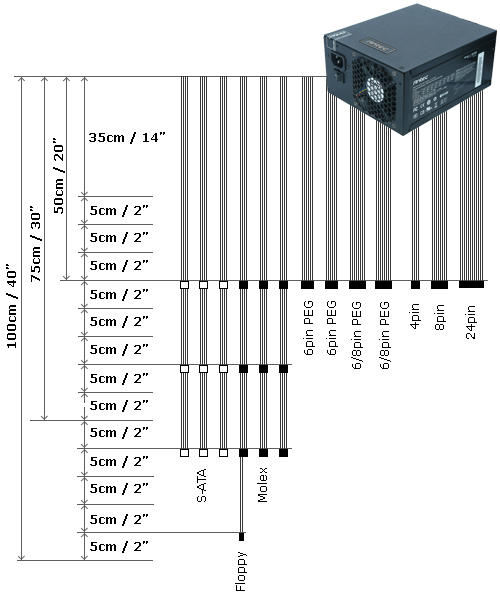
Antec has put two more of each peripheral harness in the box, which means in the end a user could have up to nine Molex and three SATA connectors or nine SATA connectors and three Molex. There are only two jacks on disposal which does mean that the four delivered extra harnesses cannot all be used simultaneously, but the user does have the choice to tailor their cable harness choice to his needs. If you're running an SLI/CF setup you are able to connect the additional two 6-pin PEG connectors to the red jacks at the back.
The Fan

There is an 80mm Nidec fan installed in this power supply. The company website unfortunately doesn't give much information about this particular fan as the only information is about the DO8A fan without the 12PS3 ending and a DO8K that has the 12PS3 ending. The problem is that DO8A is a ball bearing and DO8T is a sleeve bearing type fan. None of these fans matches the description on the back of the fan or our measured maximum speed of 4600RPM, but it can also run slow and that might be of importance in our tests.
Internals


Opening this unit is easier than we thought. There are six screws to remove, after which you just lift up the top plate. You will be greeted with a view of the backside of the PCB that holds the filtering stage and the primary side of the power supply. A few connections need to be disconnected and then you can remove the first section. The whole power supply can now slide open, which removes both the sides and the rear. The upper part that contains the primary side is fixed to the rear, which holds the jack for the power cord. The transformer and secondary side are located on the second PCB, which can be easily disconnected as all of the fixed wires go through the little opening in the side.
The filtering stage is packed, leaving no room for additional parts. In the upper picture on the left bottom side, we can also see the additional circuit to create the 5Vsb voltage. The primary side features two bulky main capacitors made by Rubycon. Both are rated with 390µF and 450V at a high temperature of 105°C, which is rare these days. Right after the caps one can see the connection that leads to the second PCB.
On the second PCB, we find the transformer in the top corner. Right on top of the large heatsink in the middle there is a temperature diode that will be responsible for the fan speed through the fan control unit. There are Nippon Chemi-Con capacitors all over the secondary side. Under the small copper plate we find the two VRM that are responsible for the 3.3V and 5V rails. Pushing all the cables aside, we found another UL number that leads us to a company called Jiangmen Glory Faith PCB Co. Ltd., the manufacturer of the PCBs.
Testing with the Chroma ATE Programmable Load
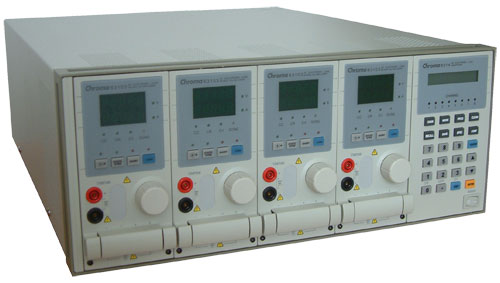
Our test equipment consists of two Chroma programmable DC Loads that enable us to test power supplies with an output of up to 1500W. The biggest advantage of the Chroma DC Loads is simply the high precision it provides. It can measure differences as small as 0.001V and 0.0001A, which will provide us with best-in-class results.
When programming the Chroma with specific amounts of load calculated according to the ATX norm, we are able to load power supplies to an exact percentage. We can now show results at every specific percentage needed. To get the best overview of a power supply, we load each unit with 10%, 20%, 50%, 80%, 100%, and 110% of the specified output. This is easy to calculate for a 1000W power supply: the 10% load is 100W and 110% load is 1100W. Remember that this is the amount of power the PSU delivers; due to inefficiencies, a power supply will actually draw more power from the wall.
Note: If you would like to know more about our testing methodology, equipment, and environment, please read our PSU testing overview.
We have added an additional 10% on the highest load to see how the units perform with overload. This test will be performed in all future reviews. The overload test is performed at room temperature as well as under more stressful conditions; to ensure we are not too cruel to the power supplies, we will keep the ambient temperature at 50°C in the stress test. Experience shows that many units can stand the overload at room temperature but will experience problems with higher temperature and overload together. Only the best-built units will survive this.
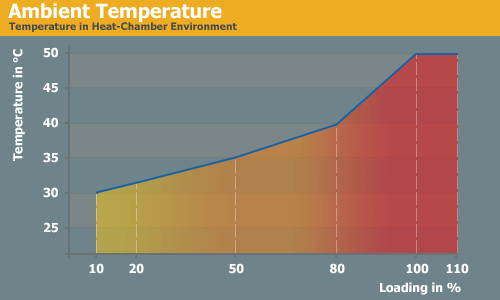
The Testing Environment
There is one flaw in testing power supplies with programmable loads while trying to measure the sound pressure levels at the same time. Because the programmable loads get very loud, there is no chance of hearing the power supply on the test stand. In order to make accurate measurements of the noise levels we needed a way to separate the test unit and the programmable loads. Our solution was to build a very thick box around the unit.
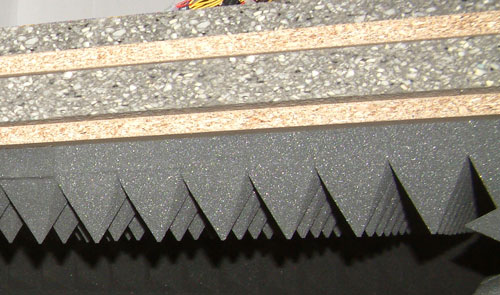
We concluded that a five-layer box with a total thickness of 6" (15cm) containing two layers of wood and three layers of special foam would suffice. It is designed as a box within a box. The inner box does not touch any part of the outer box, making it difficult for acoustic noise to pass through in the form of vibration. Each box is isolated on both sides with a layer of heavy foam that is normally used to insulate engines. On the inside we have an additional layer of 4" (10cm) thick pyramidal foam on every side of the box to eliminate the acoustic waves coming from the test object as well as we can.
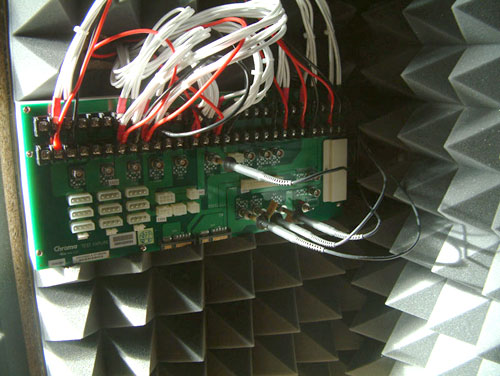
To ensure a completely closed system we installed the printed circuit board that the connectors of the power supply are attached to inside the anechoic room/box. In other box designs, you would need to put all the cables through the wall. Unfortunately, that would result in the inside of the box not being fully isolated anymore. Our design keeps everything that needs to be connected inside of the box and maintains isolation.
DC Output Stability and Quality
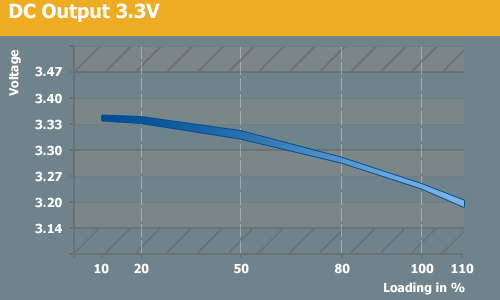
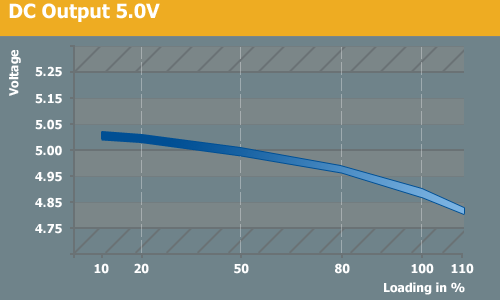
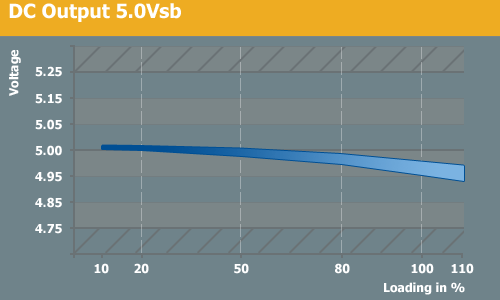
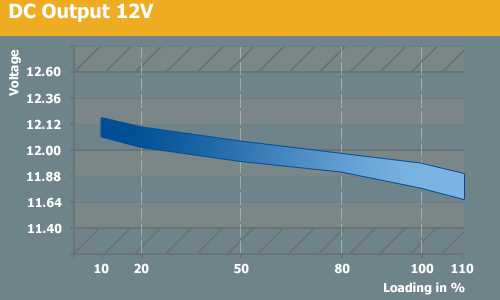
Seeing the stability of the rails like this is somewhat less than expected of a truly stable performance. All rails stay within specs and are therefore fine, but we have seen better results on competing PSUs. Even though the 12V rails don't have as much voltage drop and stay within the 3% regulation, the drop is still quite large. Both smaller rails have a regulation limit of 5%, which is again quite large, and we can see both rails heading towards the lower end of the allowed area of the ATX norm.
As for the ripple measurements, we see quite a bit of fluctuation but everything stays well within specs. At lower loads we see up to 12mV on the 12V rails and it reaches up to 26mV with higher loads. The lower voltage rails deliver really nice and clean voltage with only up to 8mV ripple.
Efficiency
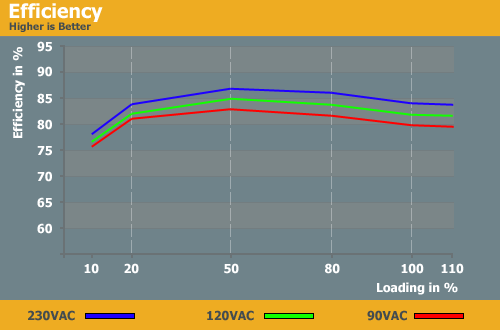
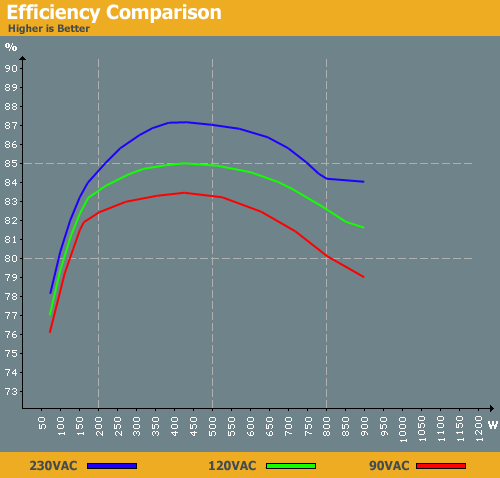
The Signature 850W power supply has great efficiency and it tops most recently tested units, especially with lower input voltages. 87% efficiency with 230VAC is very good and it even stays that high for quite a bit. With 100% and 110% loads, it maintains the same efficiency even though we normally see a significant drop at this point.
There is a reason why this unit has the Bronze 80Plus certification: with 120VAC it still reaches up to 85% efficiency and even stays above 82% most of the time. It can even reach higher grounds with only 90VAC and makes it up to 83% at around 400W. As the graphs show, users of this unit should have at least 150W of continuous power draw; otherwise, it is just not working efficiently enough. With an average power of 300W onwards this unit will have its perfect working environment.
Power Factor Correction
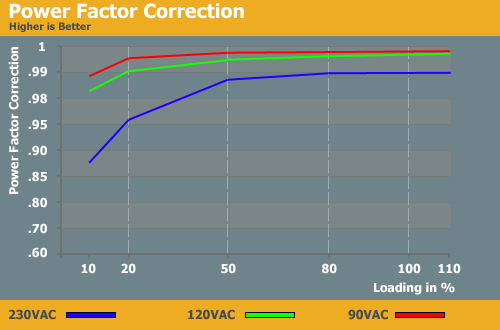
The power factor correction is one of the best we have seen to date. At lower input voltages we see a constant high level that is just not possible, presently, to better. Even Europe can build on a good correction at lower power draw.
Fan Speed and Acoustics
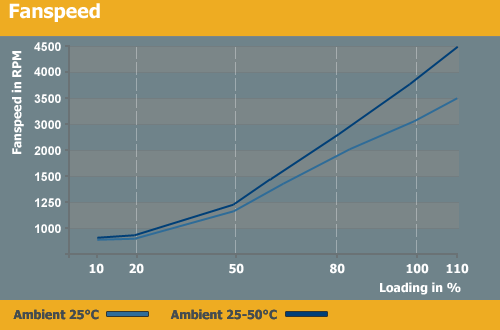
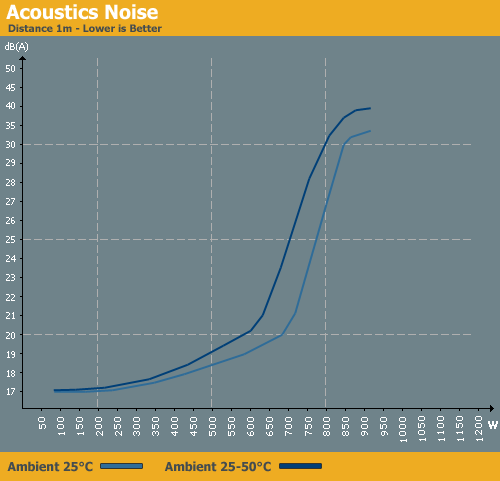
Even though we are writing 17dB(A) at loads of 10% and 20% the fan is simply not audible and the 17dB(A) is the limit of our test equipment. If you lean close to the fan, even putting your ear next to it, you will only hear a low ticking noise. To compare the fan speed vs. acoustic noise with other units, we can see the Nidec fan is doing an excellent job. At higher speeds of 1500RPM there is only a small amount acoustic noise - up to 21dB(A). We have heard other fans that are clearly audible at this point even with lower rotational speeds.
Owner of Antec's Signature power supplies will appreciate a very quiet environment up to a power draw of 600W. The fan starts spinning faster and quickly reaches ~3000RPM and a noise level of 30dB(A) onwards, which is of course clearly audible and as annoying as all other power supplies at this level. With an ambient temperature of 50°C the fan can spin at up to 4600RPM and produce 40dB(A), reminding us of the old PC Power & Cooling power supplies.
Conclusion
Since CES, the Signature series was highly anticipated and we have had the chance to take an early look at the upcoming series. We expected much from this unit and we can say the Signature delivered. The packaging gives an understated appearance to the product, which hints at the lack of need for flashy gimmicks and hype. Rather than broken promises, Antec delivers a top-of-the-line product that doesn't need many words.
The build quality was very good, starting with the housing of the unit. After looking inside, we found one of the cleanest builds possible that is further enhanced by the low height of the components. As the Signature comes with two PCBs sandwiched together there is enough space to build the tidy layout we saw today. The use of high quality components such as the Rubycon and Nippon Chemi-Con capacitors enhances the clean design.
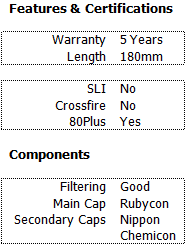 |
There are many connectors already fixed to the power supply, and users have four more jacks on disposal for additional cable harnesses if needed. All of the connectors have a minimum length of 20"/50cm, which is something of a basic standard today, though not a bad standard. On each peripheral harness are three attached connectors and the user has the choice between one fixed SATA and Molex harness and two additional cable harnesses. For users with multi-GPU setups Antec delivers two additional 6-pin PEG connectors.
Looking at performance, we saw voltage drops on the lower voltage rails as well as on the 12V rails. All of the rails perform well within specs but a drop of up to 5% is not small. As for the quality of the output, we measured a very small ripple of up to 26mV on one of the 12V rails.
Buyers of the Signature series can be happy with efficient work, as this unit achieved up to 87% efficiency. Even with lower input voltages, the unit manages up to 85% with 120VAC and up to 83% with 90VAC. These results are some of the best this year, and if the 650W version performs this well it will be a very good competitor to other offerings. That said, the 850W unit should not be used (i.e. it's overkill) with PCs that require less than 150W of power most of the time, as the efficiency is not good enough below this point. This PSU works best with a minimum of 400W power draw.
The acoustic noise was very low up to a load of 600W. Reaching that load with such a low noise was, until now, only possible from a 1000W+ unit. Users might want to take care that the load does not exceed 600W as then the fan will start spinning much faster and create a very noisy environment. The fan turns at only 700RPM at minimal load, and even when it starts spinning faster it remains quiet. Only from 600W onwards is noise a concern, where the PSU can generate up to 40dB(A) acoustic noise.
Antec states an MSRP of $249 for the 650W version and $299 for the 850W version. Both of the prices are quite high as there are 850W power supplies for much less than that, but the price will most likely drop once availability improves. The Signature series definitely left its mark today with very good performance and high efficiency. Now all we need is a more reasonable online price - it really needs to be under $200 and under $150 for the 650W model - and we'll be happy.























